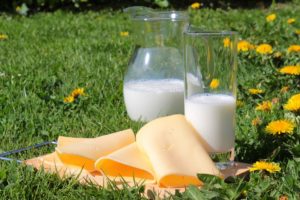The New Dietary Guidelines for Americans 2015-2020 was released this year. You may ask, “So what does that mean for me?” Find out in this 3rd post, reviewing the Guideline’s Key Recommendations and how to use them in everyday life! Today, we’re going to cover the Guideline’s dairy recommendations, but don’t forget to check out the past posts on veggies/fruit & whole grains!
The 2015-2020 Dietary Guidelines lists in Key Recommendations that a “healthy eating pattern includes… fat free or low-fat dairy, including milk, yogurt, cheese, and/or fortified soy beverages.” Dairy (or dairy alternatives) are essential to consume, but be sure to choose low-fat dairy products since many dairy products can be high in saturated fat.
How much dairy should we have? For a healthy U.S. Style Eating Pattern, we should consume the following:
- Children, 2-3: 2 cup-equivalents per day
- Children 4-8: 2.5 cup-equivalents per day
- Those 9 & older: 3 cup-equivalents per day
The Guidelines use “cup-equivalents” to explain how much of a food counts toward 1 cup’s worth of nutritional value. Thus, some foods can count for “a cup” when different amounts are consumed depending on their density. For example, 1 cup of milk counts as a cup-equivalent of dairy; but only 1.5 ounces of hard cheese counts as a cup-equivalent. Myplate.gov has a list of dairy cup-equivalents.
 Why is consuming dairy important? Dairy is the greatest source of Calcium in American diets. We all know calcium is essential for healthy bones, but calcium also helps our nerves communicate, muscles move, and heart pump. Studies show the majority of Americans don’t consume enough calcium(PDF). But if we consume recommended levels of dairy foods, the majority of us will also meet recommended calcium intake levels.
Why is consuming dairy important? Dairy is the greatest source of Calcium in American diets. We all know calcium is essential for healthy bones, but calcium also helps our nerves communicate, muscles move, and heart pump. Studies show the majority of Americans don’t consume enough calcium(PDF). But if we consume recommended levels of dairy foods, the majority of us will also meet recommended calcium intake levels.
Why is low-fat dairy important? The Guidelines emphasize choosing low-fat dairy products because dairy is often high in saturated fat. Some fat is essential to our health, but too much fat in our diets can lead to unhealthy outcomes– such as elevated bad cholesterol levels, risk for heart disease, and weight gain. Because we need calcium but also limited saturated fat, we must make smart choices!
How can I make smart dairy choices? Choosing low-fat or fat-free dairy products should not be difficult! Follow these tips to make dairy choices which are healthy and easy!:
- Don’t abruptly switch from whole milk to fat-free milk; it can take time to adjust to the different consistency. If you slowly adjust, you will be less likely to mind the difference. For example, switch from whole-milk to 2% milk first. Then after you are used to 2%, try switching to 1%.

- Purchase cheeses which are naturally lower in fat for your meals. For example, mozzarella is a cheese naturally low in fat, but cheddar cheeses are naturally high. You can usually swap cheeses in recipes, so don’t be afraid to cook your old dish, with a new cheese!
- Ask for low-fat milk/cream when ordering lattes or cappuccinos.
- Give reduced-fat dairy products a try. You can find reduced-fat hard cheese, cottage cheese, cream cheese, and sour cream. Try these reduced-fat options and you’ll be surprised at what you don’t notice!
- Enjoy frozen yogurt for dessert– instead of ice-cream. Again, you’ll be surprised at what you don’t notice!
If lactose intolerant, there are still ways to consume calcium. Visit our calcium factsheet on OhioLine for a list of dairy-free calcium sources. Click here for a list of calcium content in different food products.
